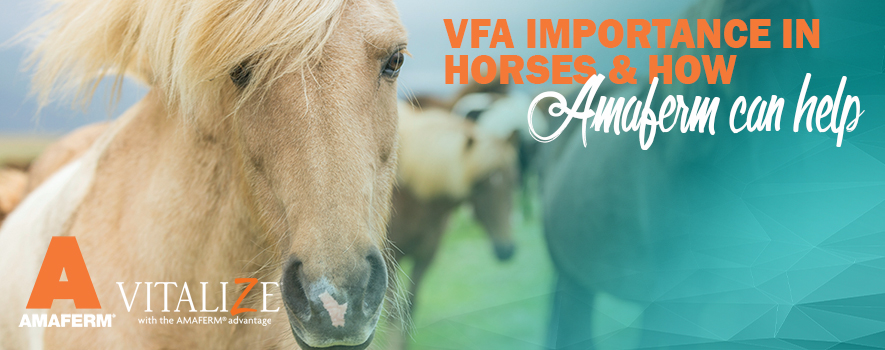Volatile fatty acids (VFAs) are a group of fatty acids produced by the cellulose digesting microbes in a horse’s hind gut. Interestingly, the microbes that produce VFAs cannot use them; they are simply a by-product of the fermentation process employed by the microbes to degrade cellulose found in forages. Instead, the horse absorbs them through the cecal and colonic epithelium and they are distributed throughout the body as energy for a wide array of biological processes.
The most common VFAs are acetate, propionate, and butyrate. Collectively, these account for the majority (approximately 70%) of the horse’s energy supply. At a basic level, this allows the horse to survive as an herbivore and contributes energy to the general maintenance of the horse including body condition, hair coat, hoof health, and the immune system. Additional burden, such as competition, stress, and lactation, require additional energy supply and, therefore, additional VFA production and absorption.
Acetate is arguably the most important VFA as it is the only one that can be directly absorbed in the bloodstream and used directly as energy. Propionate and butyrate can also be used as energy, but must first be converted into other compounds. Acetate also has significance for broodmares because it is an important source of fat in a lactating mare’s milk. As such, studies have shown that mares on a high forage diet have more milk fat than mares on a high concentrate diet.
Several components of concentrates are also broken down by microbes in the hind gut. However, the type of microbes responsible for concentrate degradation produce a different ratio of VFAs than the cellulose digesting microbes. This ratio, which contains more propionate and less acetate, is less desirable for the horse since acetate is the most accessible energy source. Therefore, although concentrate supplementation is necessary in many situations, a diet high in forage content is therefore necessary for the horse to adequately produce enough VFAs to meet his energy requirements.
Because Amaferm increases the efficiency at which the cellulose digesting microbes in the hind gut operate, horses supplemented with Amaferm have significantly higher VFA production from forages. This means the horse is absorbing considerably more energy (and nutrients) from the same amount of forage as a horse not receiving Amaferm. That’s the Amaferm advantage!



